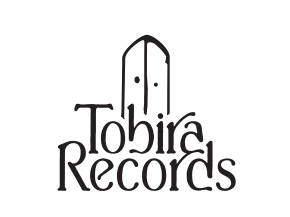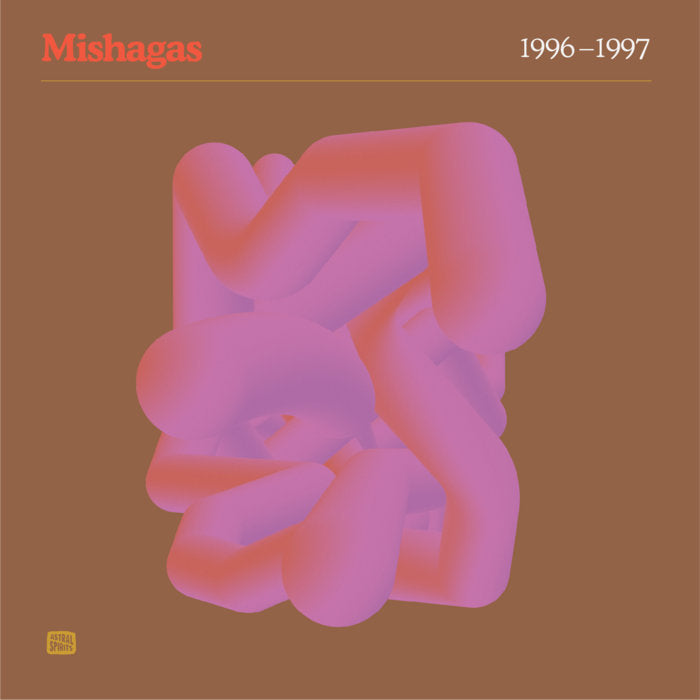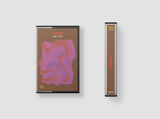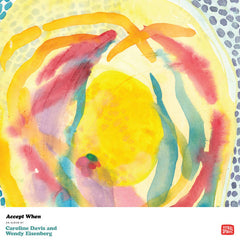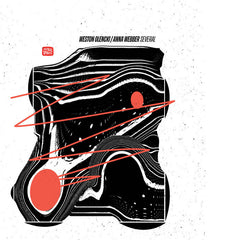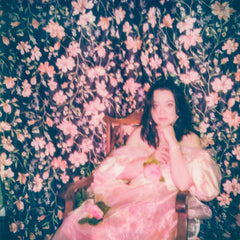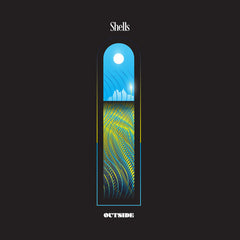Mishagas // 1996-1997 TAPE
- Availability:
アメリカ・NYのフリージャズバンドMishagasが、2022年11月に同国テキサスのジャズレーベルAstral Spiritsからリリースしたレコードです。
1996-1997年に録音したフリージャズ14曲を収録。
John Colpitts - Drums
Scott Daniel - Alto Sax
Chris Lee - Guitar
※デジタル音源をご希望の場合はお気軽にご連絡をお願いいたします
レーベルその他作品はこちら /// Click here to see more Astral Spirits releases available at Tobira.
---------------------------------
1st edition of 200.
Ask us for digital files.
Accompanying text/essay by the artist:
A priest, a drummer, and a tennis pro step onto a stage. . .
“Who is in Mishagas? Were they any good?” - Josh Fox.
I was the drummer - just out of Middlebury College and untouched by cynicism. I arrived at the doorstep of the Tribeca Knitting Factory in the summer of 1996 and landed a job booking tours for musicians associated with the venue - John Zorn, Dave Douglas, William Hooker, Thomas Chapin, Charles Gayle. It was a heady time for The Knit and sponsorship flowed freely from a few alcohol and cigarette manufacturers convinced that experimental music was profitable.
It was not.
I was sleeping on a high school friend’s floor somewhere in Manhattan. I remember coming home after my first, long day of unpaid “trial” work at the Knitting Factory and thinking - how is it possible for someone to have an office job? How do you survive this kind of shit? There is something particularly perverse and damaging about sitting at a desk for 8 hours, and to top it off, I was in a basement. I’d decided that I did not have the talent to make music - at 22 or 23 - I was too old. But a few friends still thought that playing music - just that abstract idea with absolutely no ambition attached - was desirable and possible in New York City. But the gang with whom I shared these vague dreams were not in New York yet. So I was adrift, watching a few friends scramble to play shitty shows at places like the Spiral and a threadbare CBs Gallery. You’d think I would have had some kind of connection because I worked at the Knitting Factory, but the guy who booked the club, a lanky dude named John, once stopped me with a raised finger and an arched eyebrow when I paused in front of his desk, cairns of demo tapes stacked on every surface. In the moment I gathered a breath to speak, he said, “No.”
There was a pause.
“I will not book your band here so don’t even ask.”
But yeah - I was a drummer - even though my drums had not migrated to the city yet. I did not have a permanent place to live. But as I hung out with the various interns who lurked around the Knit’s basement office - it emerged that one of them (perhaps on the same day he arrived toting a full set of audio gear, having just recorded his entire subway ride) knew a couple of guys who were looking for a drummer. Having no prospects - I was happy to meet them.
Chris Lee was the guitarist (now an Episcopal priest at Grace Church Brooklyn) and Scott Daniel the sax man who we nicknamed “Captain Jazz” (later turned tennis pro, now retired and living in Brooklyn playing acoustic finger-style guitar). They met each other at Mondo Kim’s: a multi-storied record shop and video store that was a kind of apex of hip cultural retail NYC. Right off Cooper Square on St Mark’s Place, it deserves a book all it’s own. Before the internet was populated with the entire history of recorded music - Kim’s was the place to surf for new sounds under the contemptuous gaze of the sullen staff. It was here that Chris and Scott gravitated towards each other. The way they tell it, in the absurd melange of the ultra knowledgeable that constituted the Kim’s staff, they were as normal and down to earth as possible for ESP Records hounds.
Speaking of which, the ESP catalog was the perfect amalgam of the threads that Chris and Scott were following - the sleazy White punk of The Godz and The Fugs shared a catalog with the Black loft jazz of Sonny Simmons, Albert Ayler and Milford Graves.
Chris was also obsessed with The Dirty Three and was looking to form a trio with a melodic instrument to go along with his guitar. He was getting into free jazz at the same time, so adding Scott on alto made sense.
“I was trying to play like Sonny Sharrock - not well. The tunings were all open chords - they weren’t dissonant tunings. It was all about unison, open, ringing sounds with tons of overtones. That all comes from My Bloody Valentine and the Cocteau Twins. That was my base. Kevin Shields was about as good as I could get technique-wise,” Chris told me recently.
Scott came from Minneapolis and had transitioned from punk bass, to standup, then on to alto sax. He took lessons with David Murray’s arranger Benny Russell at the Brooklyn Conservatory of Music. He had only been playing the horn for about 5 years when he and Chris started jamming together at Chris’s 2nd floor apartment on 16th St and 8th Ave in Park Slope Brooklyn.
Chris came out to a forgettable show at the Knitting Factory, and brought me a cassette of influences. The tape was programmed with tracks by the Dirty Three, Albert Ayler, and the Sun City Girls. I dutifully checked the tunes out and we made plans to jam at the Ludlow Street Studios - a basement-level rehearsal spot down the block from Katz’s Deli on the Lower East Side. The dingy rooms were equipped with amps, drums, PAs and a cassette deck for recording. We think that perhaps a few of the tunes that made the album in your hands were from our first meeting.
I was struck by Chris’s wild, emotional guitar playing and Scott’s empathetic, succinct phrasing. These guys listened a lot for young dudes in their early 20s. I tried to fit myself into the spaces - charged up by the old guard heads I was mingling with at the Knitting Factory: Sonny Murray, who demanded weed before he went on stage, Rashied Ali, whose wrists were bound to treat some intractable carpal tunnel, and Andrew Cyrille, whose ferocious, delicate and stoic performances kept me guessing. I had just come from a few months in Amsterdam, plopping myself down at the BimHuis every night, seeing all kinds of Dutch legends play to small audiences. I stirred in a little Han Bennink. I was flailing as well. Any technical shortcomings I had were papered over by shear audacity and unearned confidence. All fairly new to the city, we became fast friends and collaborators.
Since rehearsal space was at a premium I asked the band if they’d be open to waking up early to practice in the basement of the Knitting Factory. The club had backline - drums and amps - and the Alterknit Theater was soundproofed. We would arrive at around 8am - I would brew some coffee at the upstairs bar - and then we’d play for a couple of hours before I started work at 10:30am.
We learned a few songs - Albert Ayler’s “Ghosts” for one - but quickly realized that we ended up in more interesting places without the heads. “Let’s just shred,” was our mantra.
Our first show was opening for an experimental theater performance of “American Interference” at the Angel Orensanz Center. It was written and directed by Josh Fox - who went on to direct the anti-fracking documentary Gasland (among many other films). We played for about 20 minutes before the show started. We can’t remember if we were paid. Contacted for these liner notes Fox barely remembered our participation. We set up in a corner in front of the stage and we asked our friend Barry London to record us onto a 4-track cassette machine. He set up mics and we started.
After we jammed, he approached us and said - “OK I have levels. Let me know when you’re gonna do your set.”
That was the set!
Barry did manage to record a second show - but we can’t find the tape.
***
We arrived in NYC during the very last gasps of the hollowed out 80s. We played the very well lit 5th Street squat with Gold Sparkle Quartet and Sunday Puncher, a mere week before a small fire led to the building’s destruction by wrecking ball.
There were sets at ABC No Rio and the Alterknit - the small 80 person capacity room where we had morning rehearsals at the Knitting Factory. Eventually we were granted a show there, but it was probably after I took over the role of booking the club. I remember hearing that Thurston Moore came to a set and dug it, that would have been very exciting to us. Somehow the NYC shows were well attended and in the heat and the rattling crescendos, one of Scott’s friends passed out. That was the vibe.
With no significant attachments, and a naive understanding of the music business, we played constantly over the course of that year, touring around the North East and Mid-Atlantic and recording at what feels like in retrospect, an absurdly breakneck pace. Because of my connections at the Knitting Factory, we sometimes played with jazz groups that were more left of center, but still jazz. Our thing was less refined and way more punk. In Baltimore, we played with a band led by a saxophonist whose day job was with the Tommy Dorsey Band. He happened to be really into Evan Parker. But our unstudied thing did not go over well. Chris remembers, “The guitar player wanted to kick my ass after the gig - he thought I was the biggest charlatan in the world. He had come up as a punk rocker but had learned jazz guitar. I got up there, six beers in, and afterwards he wouldn’t talk to me. He wanted nothing to do with us.”
Shortly following our second tour - the band broke up. By that time - we’d hit a wall. Scott says now, “I remember asking ourselves, ‘what does it mean to improvise? We say we’re free but every gig kind of sounds the same. Why don’t we dance?’” So Chris and Scott started vocalizing and dancing on stage in the mode of Min Tanaka. They’d seen him perform solo at PS122. As I write this now, I do remember feeling a bit uneasy about the turn towards vocalizing and dance. But I was crawling around the floor rattling my heavy molded plastic cymbal case.
The guys had to remind me how disappointed I was about the break up. Shortly after Mishagas split, Oneida became more of a priority. Our first album came out in the fall of 1997 and we toured for about 3 months. I was hurt that Mishagas ended, but I poured myself into Oneida. Honestly, my time at the Knit had really soured me on the personalities of the NYC jazz scene. I stopped doing improv until I started playing with Jim Sauter in 2012 or so.
Scott moved to Seattle with his soon-to-be wife Nancy and opened an art gallery connected to a store dealing in mid-century modern furniture. Around the same time, Scott decided to release a CD of material from our time together. The CD came in a slim white cardboard sleeve with no spine. Chris designed a hand stamp that impressed “POE(1)MISHAGASlive” on the cover. The back was stamped with the label name, “Proof of Existence,” and Scott’s Seattle address. Proof of Existence - a label that no one’s heard of until now. The CD, from which most of this collection is drawn, was not exactly “Live” in the traditionally understood sense. The recordings were not all from a concert in front of an audience. Some were - but others were recorded at various home studio set ups. We simply meant - the music was created on the spot, no matter the context. These nuances were only clear to the three of us - or maybe not even that.
Unsurprisingly, the release fell through the cracks. Sure it’s tough stuff and not for everyone. The package had no spine, listed no credits or song titles or much identifying information at all. Scott never received a fan letter. It’s a peak of a kind of willful obscurantism that felt intriguing, but was maybe dumb. The CD was distributed by a few outlets and reviewed in the Wire, Willamette Week and no one else. Tom Ridge, writing for The Wire, called us “an exhilarating, combustible mixture of free jazz and avant-rock” - which I’ll take.
But despite the fact that the group barely made a whimper, and is remembered by almost no one - I still would occasionally find myself listening to the album and being moved by the noise, the dedication, and the guileless openness of it all. I always felt like we had something and I was sad, especially when I got back into improvisation after fifteen years of rock and roll, that this stuff was never heard.
Chris went on to record a number of great solo albums with no reference to our kind of thing. Oneida kept moving forward - we have a new album coming out this year. But Mishagas, during our short time alive, was as real as we might have ever gotten.
Enjoy the shred"
Artist : Mishagas
Label : Astral Spirits
アメリカ・NYのフリージャズバンドMishagasが、2022年11月に同国テキサスのジャズレーベルAstral Spiritsからリリースしたレコードです。
1996-1997年に録音したフリージャズ14曲を収録。
John Colpitts - Drums
Scott Daniel - Alto Sax
Chris Lee - Guitar
※デジタル音源をご希望の場合はお気軽にご連絡をお願いいたします
レーベルその他作品はこちら /// Click here to see more Astral Spirits releases available at Tobira.
---------------------------------
1st edition of 200.
Ask us for digital files.
Accompanying text/essay by the artist:
A priest, a drummer, and a tennis pro step onto a stage. . .
“Who is in Mishagas? Were they any good?” - Josh Fox.
I was the drummer - just out of Middlebury College and untouched by cynicism. I arrived at the doorstep of the Tribeca Knitting Factory in the summer of 1996 and landed a job booking tours for musicians associated with the venue - John Zorn, Dave Douglas, William Hooker, Thomas Chapin, Charles Gayle. It was a heady time for The Knit and sponsorship flowed freely from a few alcohol and cigarette manufacturers convinced that experimental music was profitable.
It was not.
I was sleeping on a high school friend’s floor somewhere in Manhattan. I remember coming home after my first, long day of unpaid “trial” work at the Knitting Factory and thinking - how is it possible for someone to have an office job? How do you survive this kind of shit? There is something particularly perverse and damaging about sitting at a desk for 8 hours, and to top it off, I was in a basement. I’d decided that I did not have the talent to make music - at 22 or 23 - I was too old. But a few friends still thought that playing music - just that abstract idea with absolutely no ambition attached - was desirable and possible in New York City. But the gang with whom I shared these vague dreams were not in New York yet. So I was adrift, watching a few friends scramble to play shitty shows at places like the Spiral and a threadbare CBs Gallery. You’d think I would have had some kind of connection because I worked at the Knitting Factory, but the guy who booked the club, a lanky dude named John, once stopped me with a raised finger and an arched eyebrow when I paused in front of his desk, cairns of demo tapes stacked on every surface. In the moment I gathered a breath to speak, he said, “No.”
There was a pause.
“I will not book your band here so don’t even ask.”
But yeah - I was a drummer - even though my drums had not migrated to the city yet. I did not have a permanent place to live. But as I hung out with the various interns who lurked around the Knit’s basement office - it emerged that one of them (perhaps on the same day he arrived toting a full set of audio gear, having just recorded his entire subway ride) knew a couple of guys who were looking for a drummer. Having no prospects - I was happy to meet them.
Chris Lee was the guitarist (now an Episcopal priest at Grace Church Brooklyn) and Scott Daniel the sax man who we nicknamed “Captain Jazz” (later turned tennis pro, now retired and living in Brooklyn playing acoustic finger-style guitar). They met each other at Mondo Kim’s: a multi-storied record shop and video store that was a kind of apex of hip cultural retail NYC. Right off Cooper Square on St Mark’s Place, it deserves a book all it’s own. Before the internet was populated with the entire history of recorded music - Kim’s was the place to surf for new sounds under the contemptuous gaze of the sullen staff. It was here that Chris and Scott gravitated towards each other. The way they tell it, in the absurd melange of the ultra knowledgeable that constituted the Kim’s staff, they were as normal and down to earth as possible for ESP Records hounds.
Speaking of which, the ESP catalog was the perfect amalgam of the threads that Chris and Scott were following - the sleazy White punk of The Godz and The Fugs shared a catalog with the Black loft jazz of Sonny Simmons, Albert Ayler and Milford Graves.
Chris was also obsessed with The Dirty Three and was looking to form a trio with a melodic instrument to go along with his guitar. He was getting into free jazz at the same time, so adding Scott on alto made sense.
“I was trying to play like Sonny Sharrock - not well. The tunings were all open chords - they weren’t dissonant tunings. It was all about unison, open, ringing sounds with tons of overtones. That all comes from My Bloody Valentine and the Cocteau Twins. That was my base. Kevin Shields was about as good as I could get technique-wise,” Chris told me recently.
Scott came from Minneapolis and had transitioned from punk bass, to standup, then on to alto sax. He took lessons with David Murray’s arranger Benny Russell at the Brooklyn Conservatory of Music. He had only been playing the horn for about 5 years when he and Chris started jamming together at Chris’s 2nd floor apartment on 16th St and 8th Ave in Park Slope Brooklyn.
Chris came out to a forgettable show at the Knitting Factory, and brought me a cassette of influences. The tape was programmed with tracks by the Dirty Three, Albert Ayler, and the Sun City Girls. I dutifully checked the tunes out and we made plans to jam at the Ludlow Street Studios - a basement-level rehearsal spot down the block from Katz’s Deli on the Lower East Side. The dingy rooms were equipped with amps, drums, PAs and a cassette deck for recording. We think that perhaps a few of the tunes that made the album in your hands were from our first meeting.
I was struck by Chris’s wild, emotional guitar playing and Scott’s empathetic, succinct phrasing. These guys listened a lot for young dudes in their early 20s. I tried to fit myself into the spaces - charged up by the old guard heads I was mingling with at the Knitting Factory: Sonny Murray, who demanded weed before he went on stage, Rashied Ali, whose wrists were bound to treat some intractable carpal tunnel, and Andrew Cyrille, whose ferocious, delicate and stoic performances kept me guessing. I had just come from a few months in Amsterdam, plopping myself down at the BimHuis every night, seeing all kinds of Dutch legends play to small audiences. I stirred in a little Han Bennink. I was flailing as well. Any technical shortcomings I had were papered over by shear audacity and unearned confidence. All fairly new to the city, we became fast friends and collaborators.
Since rehearsal space was at a premium I asked the band if they’d be open to waking up early to practice in the basement of the Knitting Factory. The club had backline - drums and amps - and the Alterknit Theater was soundproofed. We would arrive at around 8am - I would brew some coffee at the upstairs bar - and then we’d play for a couple of hours before I started work at 10:30am.
We learned a few songs - Albert Ayler’s “Ghosts” for one - but quickly realized that we ended up in more interesting places without the heads. “Let’s just shred,” was our mantra.
Our first show was opening for an experimental theater performance of “American Interference” at the Angel Orensanz Center. It was written and directed by Josh Fox - who went on to direct the anti-fracking documentary Gasland (among many other films). We played for about 20 minutes before the show started. We can’t remember if we were paid. Contacted for these liner notes Fox barely remembered our participation. We set up in a corner in front of the stage and we asked our friend Barry London to record us onto a 4-track cassette machine. He set up mics and we started.
After we jammed, he approached us and said - “OK I have levels. Let me know when you’re gonna do your set.”
That was the set!
Barry did manage to record a second show - but we can’t find the tape.
***
We arrived in NYC during the very last gasps of the hollowed out 80s. We played the very well lit 5th Street squat with Gold Sparkle Quartet and Sunday Puncher, a mere week before a small fire led to the building’s destruction by wrecking ball.
There were sets at ABC No Rio and the Alterknit - the small 80 person capacity room where we had morning rehearsals at the Knitting Factory. Eventually we were granted a show there, but it was probably after I took over the role of booking the club. I remember hearing that Thurston Moore came to a set and dug it, that would have been very exciting to us. Somehow the NYC shows were well attended and in the heat and the rattling crescendos, one of Scott’s friends passed out. That was the vibe.
With no significant attachments, and a naive understanding of the music business, we played constantly over the course of that year, touring around the North East and Mid-Atlantic and recording at what feels like in retrospect, an absurdly breakneck pace. Because of my connections at the Knitting Factory, we sometimes played with jazz groups that were more left of center, but still jazz. Our thing was less refined and way more punk. In Baltimore, we played with a band led by a saxophonist whose day job was with the Tommy Dorsey Band. He happened to be really into Evan Parker. But our unstudied thing did not go over well. Chris remembers, “The guitar player wanted to kick my ass after the gig - he thought I was the biggest charlatan in the world. He had come up as a punk rocker but had learned jazz guitar. I got up there, six beers in, and afterwards he wouldn’t talk to me. He wanted nothing to do with us.”
Shortly following our second tour - the band broke up. By that time - we’d hit a wall. Scott says now, “I remember asking ourselves, ‘what does it mean to improvise? We say we’re free but every gig kind of sounds the same. Why don’t we dance?’” So Chris and Scott started vocalizing and dancing on stage in the mode of Min Tanaka. They’d seen him perform solo at PS122. As I write this now, I do remember feeling a bit uneasy about the turn towards vocalizing and dance. But I was crawling around the floor rattling my heavy molded plastic cymbal case.
The guys had to remind me how disappointed I was about the break up. Shortly after Mishagas split, Oneida became more of a priority. Our first album came out in the fall of 1997 and we toured for about 3 months. I was hurt that Mishagas ended, but I poured myself into Oneida. Honestly, my time at the Knit had really soured me on the personalities of the NYC jazz scene. I stopped doing improv until I started playing with Jim Sauter in 2012 or so.
Scott moved to Seattle with his soon-to-be wife Nancy and opened an art gallery connected to a store dealing in mid-century modern furniture. Around the same time, Scott decided to release a CD of material from our time together. The CD came in a slim white cardboard sleeve with no spine. Chris designed a hand stamp that impressed “POE(1)MISHAGASlive” on the cover. The back was stamped with the label name, “Proof of Existence,” and Scott’s Seattle address. Proof of Existence - a label that no one’s heard of until now. The CD, from which most of this collection is drawn, was not exactly “Live” in the traditionally understood sense. The recordings were not all from a concert in front of an audience. Some were - but others were recorded at various home studio set ups. We simply meant - the music was created on the spot, no matter the context. These nuances were only clear to the three of us - or maybe not even that.
Unsurprisingly, the release fell through the cracks. Sure it’s tough stuff and not for everyone. The package had no spine, listed no credits or song titles or much identifying information at all. Scott never received a fan letter. It’s a peak of a kind of willful obscurantism that felt intriguing, but was maybe dumb. The CD was distributed by a few outlets and reviewed in the Wire, Willamette Week and no one else. Tom Ridge, writing for The Wire, called us “an exhilarating, combustible mixture of free jazz and avant-rock” - which I’ll take.
But despite the fact that the group barely made a whimper, and is remembered by almost no one - I still would occasionally find myself listening to the album and being moved by the noise, the dedication, and the guileless openness of it all. I always felt like we had something and I was sad, especially when I got back into improvisation after fifteen years of rock and roll, that this stuff was never heard.
Chris went on to record a number of great solo albums with no reference to our kind of thing. Oneida kept moving forward - we have a new album coming out this year. But Mishagas, during our short time alive, was as real as we might have ever gotten.
Enjoy the shred"
Artist : Mishagas
Label : Astral Spirits
